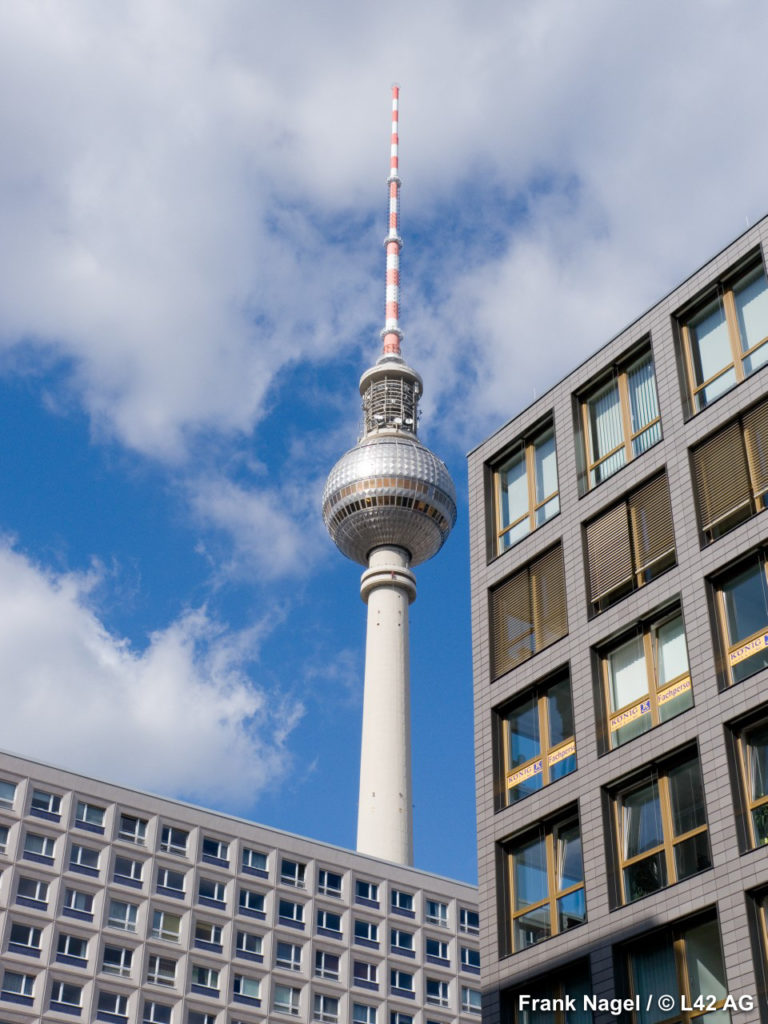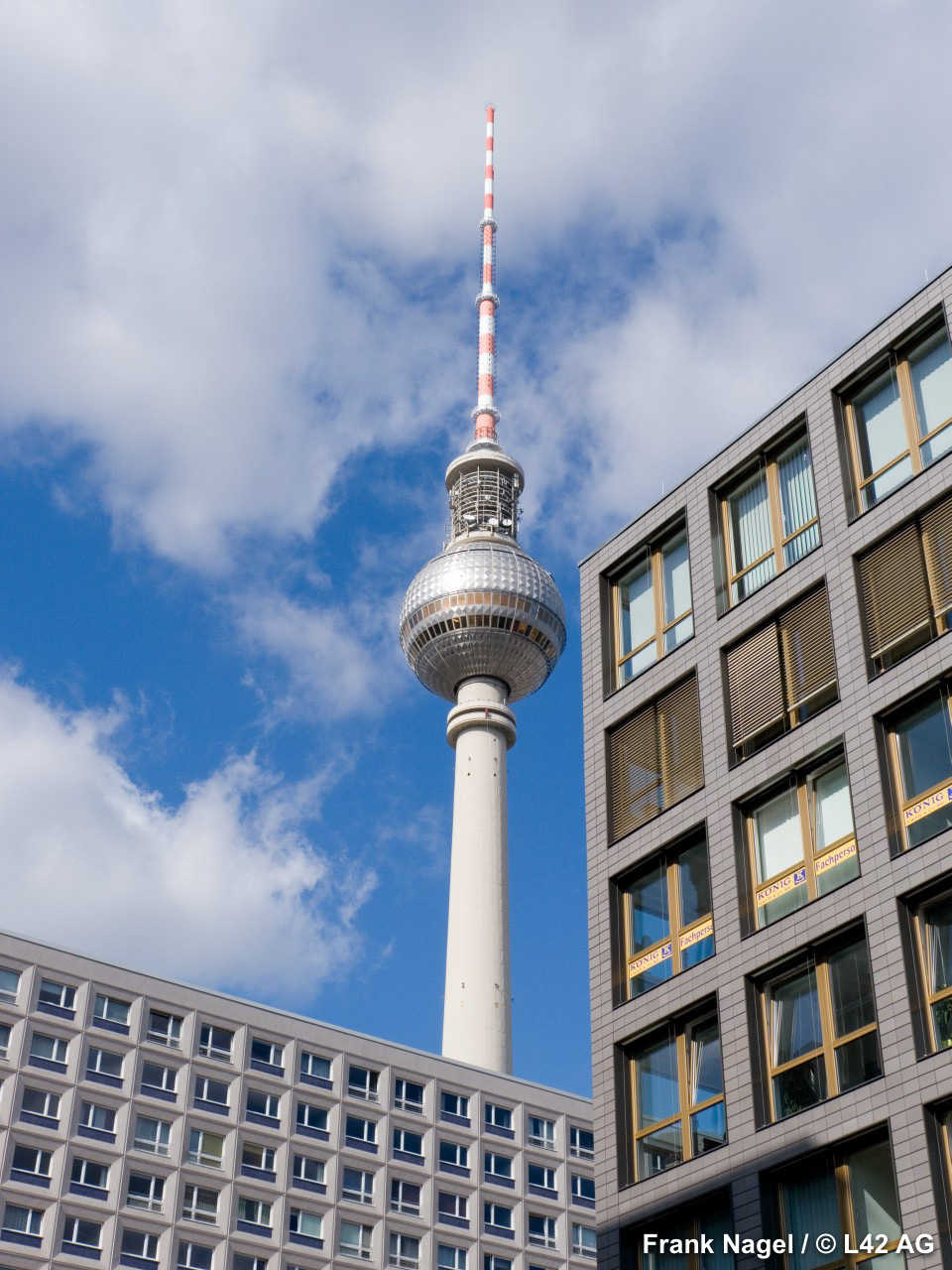
With its 368 meters (circa 1,200 feet) this very slim Valkyrie is the highest tower in all of Germany, not to mention the tallest German monument. Construction was begun in 1965 and was the tower was inaugurated on the 20th anniversary of the founding of the German Democratic Republic on October 7, 1969. At that time the young socialist republic needed a big transmitting device that would allow them to transmit without any interference. After much discussion about its potential location, it was decided that in some way it should take the symbolic place of the former castle which had only recently been demolished as a hated symbol of monarchic power. In other words they wanted to build a monumental antenna in the middle of the historic center city, which in some vague way would be representative of the city in the way the court once had been. An antenna that would celebrate the competence, the genius, the efficiency, and the avant-garde nature of the young republic. In short (if you’ll pardon the pun), a kind of poly-functional antenna doubling as an ambassador.
At first there was talk of building it upon the only natural hill of Berlin, the Müggelsberg, taking advantage of its hundred meter (328 foot) height; this, however, would have placed it too close to the airport of Schönefeld and would have thus interfered with air traffic. The idea of constructing a tower in the middle of the city, however, was simply crazy. Many technicians and intellectuals protested. They said that in Vienna, in London, and in Moscow these types of structures were always found in outlying areas. Those in power in East Berlin, however, weren’t interested: for ideological reasons they wanted to it in the center and its radio and metaphorical signals to be clear to all and sundry. An extremely tall antenna topped by a sphere, the unambiguous cosmic symbol of wholeness and perfection. More a myth than a transmitter, really, in complete unity with that of Sputnik.
It was built by a rather emblematic collective of architects. Ferocious power struggles within the party led the complex project to be awarded at one point to this architect, at another to that one. As in many details to arrive from out of East Berlin there was a mixture of disinformation, manipulation, cover-ups, conspiracies, and then at long last a kind of surface truth was prepared that would be convincing enough to all. The most important thing was to retain control over everything and everyone; anyone who was to express a personal vision for the project was always made to feel as if they had been controlled and compliant. Whoever refuted such logic was immediately discredited, defamed, and persecuted. The architect and president of the Bauakademie Gerhard Koser long maintained that he had been the father of the project and even brought to court all the documentation supporting his claims. It is curious, however, to learn that all the documents in his favor somehow disappeared from the official archives and he was only recognized as its father after the end of the regime. That stated, the Fernsehturm is undeniably a complex symbol of contemporary architecture and required the expertise of people from various fields; therefore it is understandable that credit for its creation belongs to a number of different people. It is undeniably Gerhard Kosel’s child from the aesthetic point of view, Gerhard Frost’s from the functional point of view, and Gerhard Probst’s from the radio-technical point of view. Jean Fougeron was the first person, in any case, to say that the tower should be raised in the center of the city and crowned by a sphere. Hermann Henselmann was long considered the most trustworthy of its fathers (seeing as that he had designed another one already) even though he wanted it to be built elsewhere. Fritz Dieter patented the construction of the sphere and with him we must also consider Günter Franke and Werner Ahrend. Werner Neumann is also credited with being one its creators. The working-class hero Walter Tuchen might well be considered as, from the practical point of view, the one who made the construction of this extremely tall spire possible. A good part of the paternity claim therefore also belongs to him. That which appears to us today, half a century later, a peaceful historical tale of a combination of different forces was, during the time of the socialist government, cause for a great amount of anguish and bitterness.
The tower was erected between 1965 and 1969 and, together with her, the costs. The party didn’t know how to hide them any longer. Construction lasted fifty-three months. “A record!” they cried from East Berlin, as if the people could no longer distinguish fifty-three days from fifty-three months. There were three hundred companies involved and the workers worked in shifts of three: about sixty were involved every day and thirty at night. In the end, the total cost was close to 132 million marks and the government of the GDR had to spread this number among various funds to save the balance.
But, on October 3, 1969, the German Democratic Republic got color TV.
The fact that the sphere required climate control, elevators, and a special type of steel for its construction was considered by some to be a betrayal of the revolution in as much as neither the steel, the elevators, nor the climate control systems were produced in the GDR. The TV Tower thus suffered the dishonor of not being completely home-produced, of being, if you will, a bit of a bastard. And – adding insult to injury – it was long mocked by the West (out of jealously, naturally). They told her that she resembled an asparagus and called her the Telespargel. They said that the cross of lights reflected by the sun across the sphere was a sign of the “Pope’s ire” towards the socialist republic. They called her “St. Walter” after President Ulbricht…In short, you could say she had a bit of a difficult childhood.
“Oh giorni orrendi in così verde etate!” (“O what horrible days in the bloom of youth!”) the poet proclaims. As if Leopardi’s mal di vivere was in any way applicable to the GDR’s young ambassador. But we digress.
When the TV Towers ceased being a socialist, a new life for her began, a bit less glorious perhaps, but certainly more joyful. The poet spreads his arms, palms down, to remind us that it was here, for example, that in 1995 the funambulist Matthias Traber intended to walk his tightrope of 36 mm between the antenna and the cathedral for a total of 620 meters (2034 feet), even if in the end he was to fall around the Neptune Fountain. However, the tower was also very useful in 1998 for the race up its stairs, won by Thomas Munkelt who managed to take the 986 stairs in only five minutes, fifty-six and eight-tenths of a second. In 2006 on the occasion of the World Cup being played in Germany the sphere was made to look like a soccer ball…And the TV Tower is always happy to participate in the festival of lights. In short, today she is a presence that has been well integrated into the reunited Berlin. There’s only one little thing.
How can she obtain a paternity test if the old archives are untrustworthy and the old fathers have, for the most part, died? The poet has no doubts whatsoever. Mater semper certa est.
Translated by Alexander Booth

